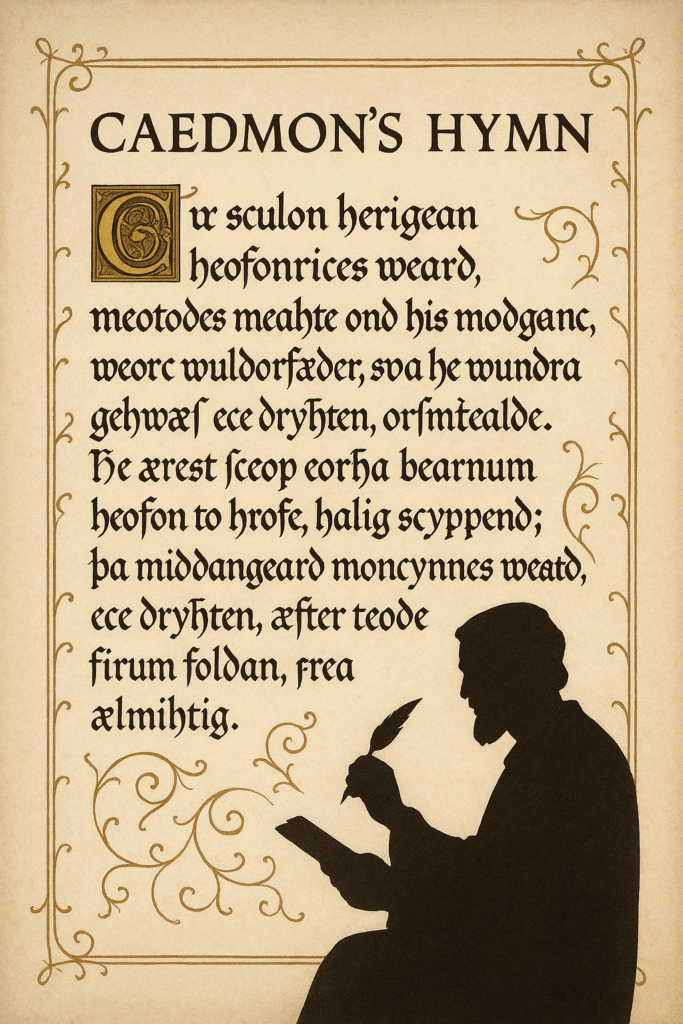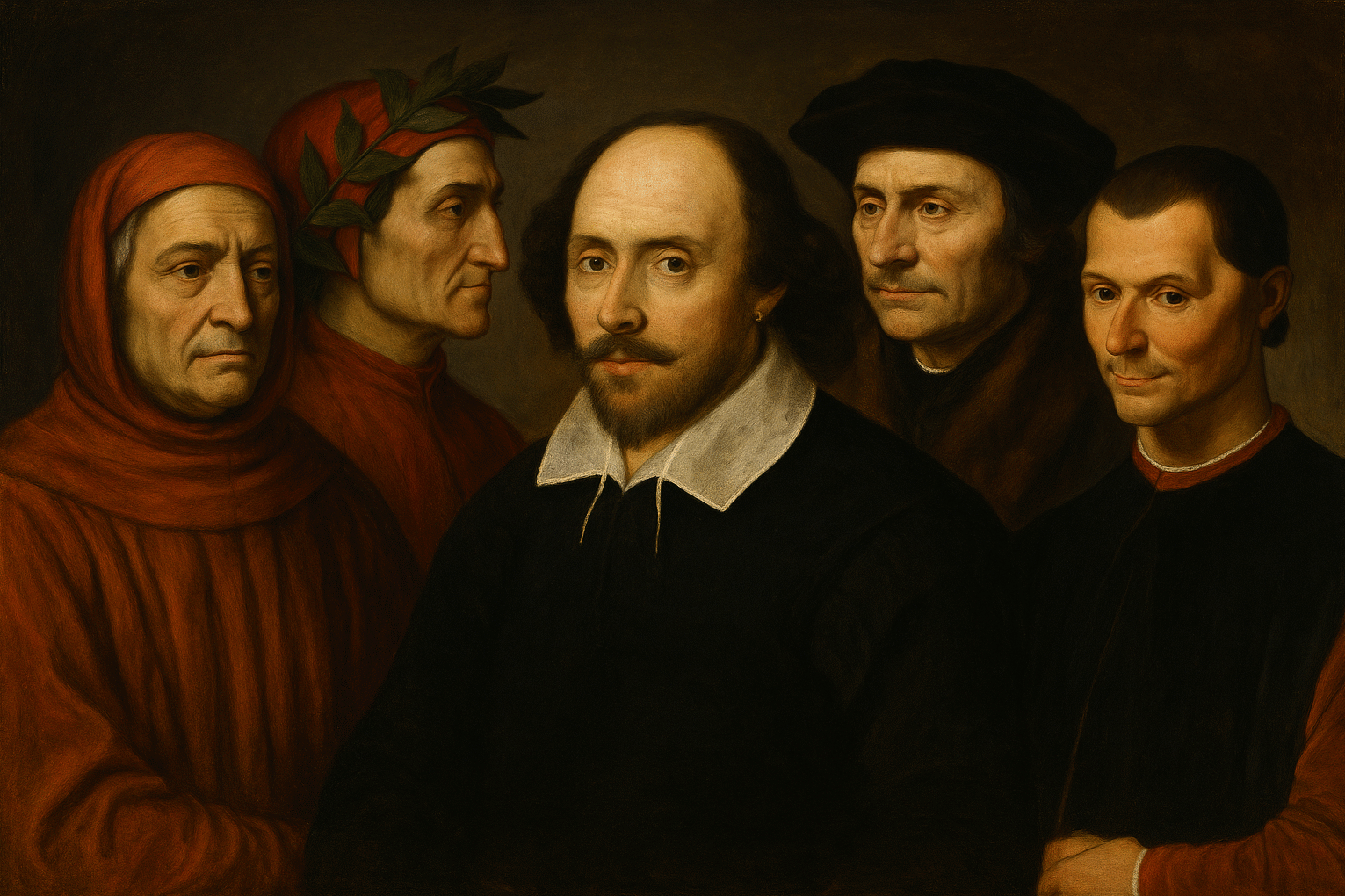Article (3): Summary and Significance of Caedmon’s Hymn in Anglo-Saxon Literature
Article (3): Summary and Significance of Caedmon’s Hymn in Anglo-Saxon Literature
Caedmon’s Hymn: A Detailed Study
Caedmon’s Hymn is one of the most important works in the history of English literature. It is considered the earliest surviving poem in the English language. Although the hymn is very short, its historical, religious, and literary value is enormous. It represents the first known effort to use the English language to praise God in poetry. In this note, we will study the background of the hymn, its story, themes, style, structure, language, significance, and its lasting influence.

Background of Caedmon’s Hymn
Caedmon’s Hymn comes from the Anglo-Saxon period, also known as the Old English period, which lasted roughly from the 5th to the 11th century. During this time, most poetry was oral, and stories were passed down through generations by memory. Written records were rare because few people were literate, and most writing was done in Latin, not English.
According to the historian Bede in his book “Ecclesiastical History of the English People,” Caedmon was a humble cowherd working at the monastery of Whitby under Abbess Hilda. He was shy and avoided singing or performing poetry with others because he believed he lacked the skill. One night, while sleeping in a stable, Caedmon had a vision in which a divine figure asked him to sing about “the beginning of created things.” Miraculously, Caedmon began to compose a beautiful hymn in praise of God’s creation.
When he awoke, he remembered the hymn perfectly. His talent was recognized by Abbess Hilda, who invited him to join the monastery. There, he continued to create religious poems, but the only surviving work we have today is the hymn he first sang.
Thus, Caedmon’s Hymn is not just a poem; it is a miracle in Christian belief, a symbol of divine inspiration.
Text and Translation of Caedmon’s Hymn
The original hymn was written in Old English. Over time, several versions were recorded by scribes. Here is one version of the Old English text:
Nu sculon herigean heofonrices Weard,
Meotodes meahte and his modgeþanc,
weorc Wuldor-Fæder, swa he wundra gehwæs,
ece Drihten, or onstealde.
He ærest sceop eorðan bearnum
heofon to hrofe, halig Scyppend.
Þa middangeard moncynnes Weard,
ece Drihten, æfter teode
firum foldan, Frea ælmihtig.
Here is a simple modern English translation:
Now we must praise the Guardian of the heavenly kingdom,
The power of the Creator and his wise thought,
The work of the glorious Father,
How He, the eternal Lord, established every wonder.
He first created heaven as a roof for the children of men,
Holy Creator.
Then the middle-earth, the Guardian of mankind,
The eternal Lord, afterwards made,
The earth for men, Almighty Lord.
The hymn is a song of pure praise to God, focusing on His power as the Creator of the universe.
Themes of Caedmon’s Hymn
1. Praise of God:
The main theme is the glorification of God. Caedmon praises God as the “Guardian of Heaven,” the “Glorious Father,” and the “Almighty Lord.”
2. Creation:
The hymn talks about the creation of heaven, earth, and mankind. It celebrates God’s creative power.
3. Divine Wisdom:
It highlights not just God’s strength but also His wisdom and thoughtful planning in the creation of the world.
4. Humility and Worship:
The hymn encourages humility before God and worship through song and poetry.
5. Eternity:
It speaks of God as the “Eternal Lord,” emphasizing the everlasting nature of the divine compared to the temporary nature of human life.
Style and Structure
Even though Caedmon’s Hymn is short, it shows many features typical of Anglo-Saxon poetry:
1. Alliteration:
The hymn uses the repetition of consonant sounds at the beginning of words, a key feature of Old English poetry. For example, “Meotodes meahte and his modgeþanc” (the might of the Creator and His mind’s thought).
2. Oral Composition:
The structure of the poem makes it easy to memorize and recite. Short lines and rhythmic patterns help in oral tradition.
3. Variation:
Caedmon uses multiple names and titles for God, like “Guardian,” “Creator,” “Father,” and “Lord,” to enrich the poem.
4. Economy of Language:
Each word is packed with meaning. There is no waste or unnecessary decoration.
5. Elevated Tone:
The hymn uses a solemn, respectful tone fitting for praising God.
6. Simple yet Majestic Language:
Although the language is simple, it carries a majestic and grand feeling because it speaks of divine matters.
Language of Caedmon’s Hymn
The hymn is written in Old English, also called Anglo-Saxon. This form of English looks and sounds very different from modern English. It was a Germanic language with heavy use of compound words, strong inflections, and different sentence structures.
Some important features of Old English seen in the hymn are:
- Compound Words: Words like “heofonrices Weard” (Guardian of the heavenly kingdom) combine multiple ideas into one strong phrase.
- Use of Metaphors: Referring to heaven as a “roof” shows the poetic imagination at work.
- Strong Verbs: Old English verbs often changed form to show tense and subject, making the language very flexible for poetry.
Although we only have a short sample, Caedmon’s careful use of language shows he had great natural talent.
Significance of Caedmon’s Hymn
1. First English Christian Poem:
Caedmon’s Hymn is the first known religious poem in English, showing the beginning of a new Christian literary tradition in England.
2. Survival of the Vernacular:
At a time when Latin dominated religious writing, Caedmon’s use of English helped preserve and elevate the native tongue.
3. A New Kind of Poetry:
Instead of focusing on warriors and battles, Caedmon’s Hymn focuses on spiritual matters, showing a shift in cultural values.
4. Influence on Later Poetry:
Later poets like Cynewulf, and even anonymous authors of works like The Dream of the Rood and Beowulf, were influenced by the model Caedmon provided — combining Christian faith with traditional poetic forms.
5. Symbol of Divine Inspiration:
The story of how Caedmon received his gift has become a symbol of divine grace and the belief that God can empower anyone, regardless of their social status.
6. Important for Historical Study:
For historians, the hymn provides a valuable glimpse into the early blending of Christian and Germanic cultures in England.
The Story of the Hymn’s Recording
The hymn was preserved because of Bede’s careful recording. He included the story in Latin in his “Ecclesiastical History” but also gave a rough translation of Caedmon’s Old English hymn into Latin.
Later scribes translated Bede’s Latin back into Old English and inserted Caedmon’s Hymn into manuscripts. As a result, we have several slightly different Old English versions of the hymn. These variations show how oral tradition worked and how texts evolved over time.
Manuscripts and Preservation
Caedmon’s Hymn survives in at least 21 known manuscripts. Some are written in Old English, some in Latin, and some contain both. Important manuscripts include:
- The Moore Bede (Cambridge, University Library)
- The St. Petersburg Bede (Russia)
- The Tanner Bede (Bodleian Library, Oxford)
These manuscripts helped scholars piece together the history and evolution of the hymn.
Literary Devices Used in Caedmon’s Hymn
1. Kenning:
A kenning is a metaphorical expression, like “heaven’s roof” for sky or “Guardian of mankind” for God.
2. Parallelism:
Repeating similar ideas or structures to emphasize points, as seen in the repeated praises of God.
3. Epithet:
Using descriptive titles like “Glorious Father” adds grandeur to the subject.
4. Alliterative Verse:
The poem follows the Anglo-Saxon style of linking words with repeated initial sounds for rhythm and beauty.
5. Synonym Clusters:
Different words with similar meanings are used for God to enrich the poem and reflect God’s infinite qualities.
Influence on Anglo-Saxon Christian Literature
After Caedmon, many Anglo-Saxon poets wrote religious poetry in English. These poets built on his foundation. Works like:
- The Dream of the Rood
- Christ by Cynewulf
- Genesis (an Old English poetic version of the Bible)
show how Caedmon’s model inspired a whole tradition of religious English poetry.
Without Caedmon’s Hymn, it is possible that religious poetry in English would have developed much more slowly.
The Modern View of Caedmon’s Hymn
Today, scholars see Caedmon’s Hymn as a turning point. It is not just the earliest surviving English poem but also an example of how art and faith combined in Anglo-Saxon culture.
Modern translations and studies of the hymn reveal its deep beauty and sophistication. Despite its short length, the hymn manages to:
- Celebrate creation
- Express deep faith
- Show the power of simple, heartfelt language
Many scholars also admire how the hymn preserves the sound and rhythm of early English, making it a precious artifact of the English-speaking world’s beginnings.
Conclusion
Caedmon’s Hymn may be only a few lines long, but its importance is vast. It marks the birth of English religious poetry and shows how even the humblest person, through divine inspiration, can create something timeless and beautiful.
Caedmon’s Hymn teaches us about faith, humility, the beauty of the natural world, and the power of language to praise and inspire. It also reminds us that great art can come from unexpected places and that divine gifts can be given to anyone, regardless of their education or background.
In studying Caedmon’s Hymn, we connect not only with the earliest days of English literature but also with the timeless human desire to understand, praise, and glorify the mysteries of creation.
Thus, Caedmon’s Hymn is not just a poem; it is a bridge between the ancient world and today, carrying with it the enduring message of faith, wonder, and the power of simple but profound song.
To read the notes on English for classes 9,10, Inter Part-1 & 2, follow the links.
https://englishwithnaeemullahbutt.com/
To read Caedmon’s role in Anglo-Saxon Poetry, follow the link.
https://englishlitnotes.com/2025/04/27/caedmon-anglo-saxon-poetry-contributions/
Discover more from Naeem Ullah Butt - Mr.Blogger
Subscribe to get the latest posts sent to your email.
